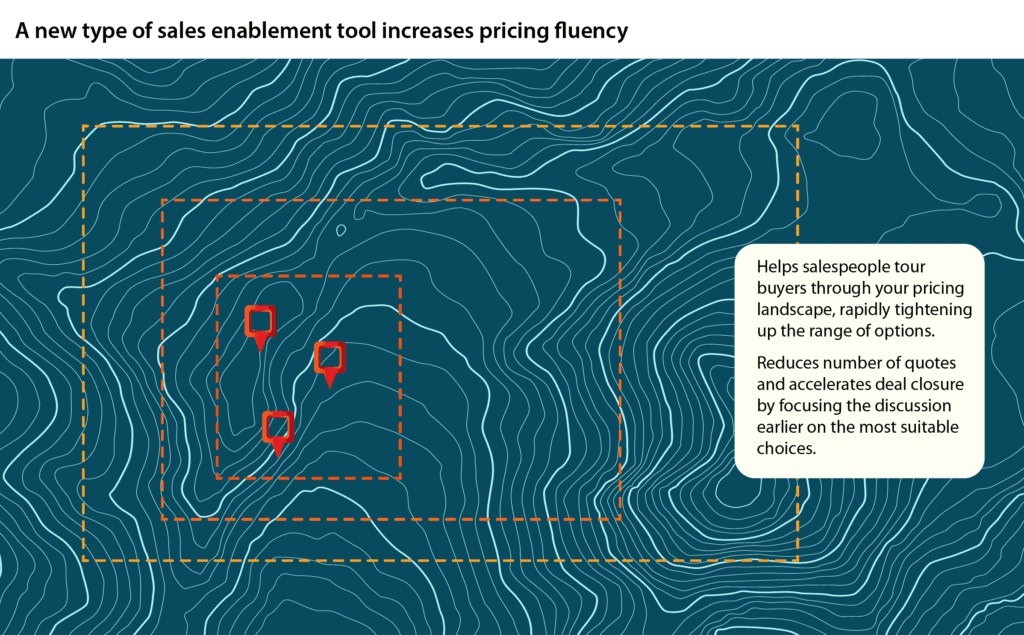B2B software providers can do more to equip their salesforces for success
My first blog in this series explained why borrowing B2C methods for value-based pricing doesn’t work for B2B software. The second looked at B2B value-based pricing methods that do work. Now I’d like to wrap up the series with some ideas for helping salespeople successfully sell on value.

Sales teams are constantly being exhorted to “Sell on value!” At the start of my career, as a software sales rookie, those were the words ringing in my ears.
Most salespeople try their best to deliver, even though they may not be specifically trained to engage buyers in productive conversations about value. They try even though their company’s monetization strategy may make it near-impossible to keep value front and center during the sales process. In fact, for B2B software, the critical elements in successful value-based selling need to be put in place long before the first sales contact.
In this post, I’ll cover three things to do at the monetization design stage and three at the go-live stage that will lay the rails for successful value-based selling.
How to improve value-based selling through monetization design
1. Package software to match buyers with their needed solutions and eliminate most one-off deals.
When you look beyond value perception to how customers actually derive value from usage, you’ll discover similarities you might not have expected. I’ve told the story of heavy equipment companies and wedding planners using equipment rental software in nearly the same way. And even though it might seem counterintuitive, some large enterprises and SMBs need similar HR software capabilities—the common denominator is how they have organized around their operations.
My message is that customers are often more alike than they appear. Once you get that, your packaging can be extraordinarily simplified—which, in turn, will simplify the process of value-based selling.
This approach to packaging will also help you eliminate the basis for most partial-use arguments, which corrode value-based selling. For example, let’s say you offer a standard software package with 10GB of storage, an advanced package with 25GB and an enterprise package with 50GB. Your sales team will encounter buyers who are happy to upgrade but don’t need all the storage in the next step up. They’ll all request a discount.
A good salesperson will, of course, fight for a fair price for the customer. With poor packaging, many of these partial-use cases and other one-off scenarios will create friction in the sales process, distracting from value-based discussions and slowing down deal velocity. Combine that with discretionary discounting, and it is impossible to determine what is working and not working within your monetization strategy.
You can avoid these drags on revenue, growth and profit by using monetization-specific frameworks to guide packaging decisions. The more common approach of relying on marketing frameworks, such as buying personas, can over-complicate packaging (often leading to hyper-gearing, where many features are metered), creating a nightmare for salespeople.
2. Create a simple pricing model that reflects value derivation from software usage.
Pricing is attached to an offer—a combination of products and services (a.k.a. a “package” or an “edition”). So if you haven’t done #1 above, you could end up struggling to price too many SKUs, each a unique combination of a package with optional add-ons or components. The result could be list prices misaligned with usage-derived value at different unit volumes. You might have clashing rate cards with tiered discount schedules that work independently but produce weird mathematical effects that undercut value when salespeople try to blend them into a deal. You can also end up with overly complicated sales operations and supporting systems, requiring large investments to automate licensing entitlement and management.
In contrast, optimal pricing models are systematic and programmatic, using data and formulas to remove ambiguity. They reflect how customers gain value from the product, cover edge and corner cases, work for large and small organizations, address a full range of ordering scenarios and continue to make sense to customers as they expand deployments.
Try not to create too many variables, which not only make salespeople’s brains explode but invite gaming and exploitation from buyers. Avoid tiered pricing schedules, which can depress revenues and make accurately forecasting them near impossible. Instead, move into continuous discounting, where customers earn more discounts as they spend more—encouraging them to increase upfront commitments.
Rules of thumb:
- The simpler your packaging, the simpler your pricing can be.
- If your salespeople don’t understand the value-based rationale behind your packaging and pricing, they won’t be able to present and explain it to buyers in a manner that builds confidence in the deal and trust in the relationship
3.Establish a structured incentive framework that enables buyers to earn advantages.
Okay, so now your software is packaged for classes of customers who derive value from usage in similar ways. Your pricing is a simple reflection of that value. There’s one more thing you need to accomplish ahead of go-live: Design a framework of structured incentives that encourages favorable buying behaviors in ways that support value-based selling.

The ideal framework shifts buyers away from the notion that they ought to be given discounts. Instead, you want to convey that customers earn discounts and other incentives as they spend more. Most importantly, make it clear that every buyer has the same opportunities to earn these advantages. We call this Market Fairness Pricing. Without it, you’ll be forever giving discounts to those who scream loudest. Buyers learn quickly to scream louder and louder (especially a buyer who just heard a colleague from another company bragging about getting a massive discount from you).
Your framework may include various incentives, such as rewards for purchasing multiple products and for accepting shorter payment terms or longer contract lengths. You might offer, for example, global pricing that addresses customers’ ability to pay in a depressed currency situation. The most powerful incentive, however, is usually around purchase volume.
How are you going to encourage customers to buy more? While this question may seem obvious, we’ve encountered well over a hundred software providers that still price based on list x volume. At large volumes, the multiple can end up being a ridiculous number. Salespeople resort to deep discretionary discounting to avoid having to quote multimillion-dollar monthly subscription prices. But how can you sell the value of your software when you’re giving it away at a 99% discount?
The negotiation is quite different when your pricing model and packaging have been optimized for your typical customer classes (organizations that derive value from your software in similar ways). As an integral part of your pricing model, your structured discount framework provides customers with reasonable volume discounts. Salespeople can discuss these discounts clearly and unambiguously without undercutting software value. On the contrary, salespeople are on solid ground when assuring customers that buying more will enable expanded usage, increasing the value derived from use.
How to improve value-based selling at go-live
1. Make your sales team pricing fluent.
Everyone in sales is familiar with situational fluency—the ability to quickly understand what the buyer is telling you about their needs. Fluent salespeople respond with agility when faced with new information or situational changes. They promptly reset and present suitable offers and information to move the sales process toward closure.
Pricing fluency is a less-known concept, focused on the economics of the deal. It’s the ability to go beyond the usual focus on price and ROI. Fluent salespeople can quickly and clearly explain how your pricing model works, show how it scales, and help buyers explore options and narrow them down to the best choices. They have the agility to come up with relevant examples and accurately answer “what if?” on the fly.
How do you help your sales team become pricing fluent? Start with simple, understandable, explainable packaging and pricing (see above). Have salespeople practice with expected and unexpected customer scenarios and requests. Give them sales enablement tools (see below) for call preparation and real-time support during conversations with buyers.
2. Support pricing fluency with tools that also capture detailed data and customer insights from the sales process.
LevelSetter, our new sales enablement tool, helps salespeople tour prospects through pricing landscapes in a transparent, collaborative way that elevates buyer trust. It reduces the number of quotes generated and accelerates deal closure by focusing the discussion earlier on the most suitable options.
During call preparation, salespeople use LevelSetter to rapidly configure a starter range of deal options. During the call, users can quickly add information or change a parameter as new information and requests arise. LevelSetter generates alternative deal structures and charts comparisons to help tighten up the range of options. Salespeople can show buyers visually how discounts are earned. They can also use comparisons to help buyers understand not only current cost and value, but future cost and value if they add users or other software packages. In fact, some of our customers are embedding LevelSetter into their billing systems so their customers on usage-based pricing can forecast their costs and adjust as needed.
LevelSetter also provides what you might think of as a “fluency overlay.” It displays a breakdown of deal economics, such as TCO, discount dollars, discount percentage and per unit pricing. There’s also sample language to help salespeople talk prospects through their options in a manner that emphasizes value and earned discounts.

During the entire sales process, LevelSetter captures detailed data on every deal closed and explored—a source of substantial customer and market intelligence. This data is pure gold for sales training and evaluation, and it’s also available via APIs to other parts of the organization. Finance can use it to improve the accuracy of net price predictions and thus of scenario planning. Product management can use it to better understand what customers value and will pay for (as opposed to what they tell a survey they’d be willing to pay—proven to be error prone and essentially meaningless).
3. Prepare salespeople to elucidate comparative value when your monetization strategy changes.
Another benefit of a pricing fluency support tool is that it can help you transition legacy customers when you change software licensing, packaging or pricing. Maybe you’re shifting from on-prem licenses to cloud-based SaaS subscriptions. Or perhaps you’re already cloud-based but moving from per-user pricing to some form of usage-based pricing. When you make significant changes like these, there are various ways of bringing legacy customers along with you.
The worst way is using grandfathered pricing tactics, where you allow them to retain their current payment structure. That all-too-common practice erodes both transitional and future revenue streams.
The best way is by helping legacy customers understand what is changing and how the new structure will provide them with increased value. Pricing fluency tools, which enable salespeople to compare and walk customers through “old world” and “new world,” are a huge advantage. For example, LevelSetter creates ramp schedules and formulaic ways of bridging customers to new pricing. Use it with an optimized pricing model, and you’ll avoid the risk of trapping existing customers into overly large pricing changes that could exacerbate churn.
To find out more about optimizing pricing for value-based selling, keep reading this blog, or contact me: chrismele@softwarepricing.com.




